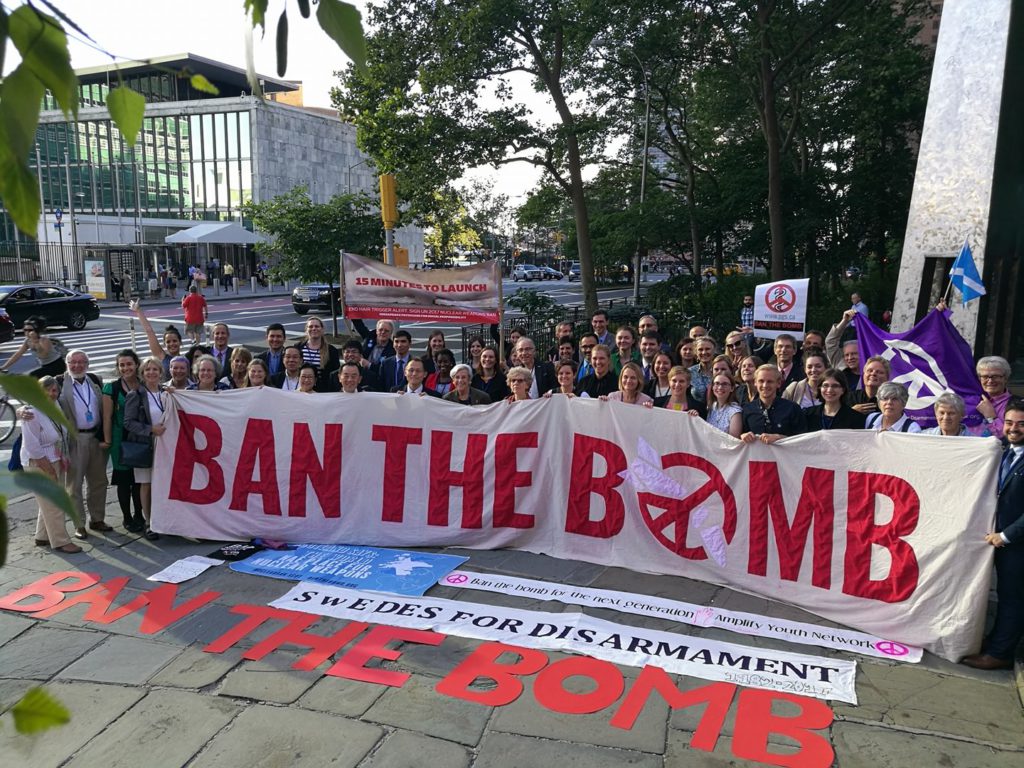More than 2/3 of UN Members are in New York negotiating a treaty to ban nuclear weapons. The first read through of the treaty finished yesterday, and these governments had the opportunity to give their comments and feedback on all parts of the draft text. What happened and what’s next?
What happened so far:
Overwhelmingly, there was strong support for a good categorical prohibition on nuclear weapons. A lot of countries have taken the floor, making suggestions for things to add (or take out) of the treaty. Compromises are already being worked out and proposals are coming from the floor on a regular basis.
The preamble
The first part of the treaty text is designed to be the message to the world. This is where the negotiators put their hopes and visions and express what it is that is driving them to negotiate new international law. For this treaty, the clear emphasis in the preamble which was reinforced during the first discussions, was that any use of nuclear weapons, under any circumstances would cause a humanitarian tragedy that could never be adequately dealt with. This treaty will form part of the body of international humanitarian law and it is hoped that it will also reinforce the principles international human rights and environmental law.
General Obligations
This section of the treaty talks about what will actually be prohibited once it is in force. The draft had already covered key aspects – from the production and manufacture of nuclear weapons to their use. States argued that other things should also be included, such as military preparations for the use of nuclear weapons, a clear obligation for stockpile destruction and an end to financing of nuclear weapon producing companies.
Declarations, Safeguards, Stockpile destruction
It was clear that countries wanted to talk about these three elements as a package. This is completely logical, as first you declare what you have, then you fix a plan to destroy the weapons, and finally you make sure all materials that put the nuclear in nuclear bomb are safeguarded and kept away from weapons forevermore.
A lot of discussion took place in this section, with eloquent proposals coming from Ireland – suggesting that all states parties be required to maintain the obligations they have in force, including on safeguards, monitoring or verification, without prejudice to any higher level of safeguards that may be adopted in the future. There was also a nice new package for consideration by Austria and South Africa.
These are all efforts to make sure this treaty leaves the door open for nuclear – armed countries to join. It is also important that this package is designed in a way that allows future treaties or agreements to come into force that will work to maintain a world free of nuclear weapons. (Things like a fissile materials treaty, or the entry into force of the comprehensive test ban treaty, or negotiated disarmament agreements among nuclear-armed states). The principles of irreversibility and verifiability should also be kept in mind as negotiations continue.
Positive Obligations
Ensuring the rights of victims, doing everything possible to protect the environment, and making sure that you help when help is needed- that’s the basics of the positive obligations outlined in the treaty so far- or at least the ideas behind it! This is a really important section of the treaty. It adds emphasis to the collective responsibility to make sure there are never any nuclear weapon victims again (by making it an obligation to help) and it also works to make sure that there is every effort to make sure that the rights of those affected are provided for. There is also a push to make sure that the obligation to provide assistance to others- legally, financially or in other ways- becomes part of the treaty. The folks at the Harvard Human Rights Clinic, PACE University, Mines Action Canada and Article 36 have made a series of papers on this, explaining eloquently what is needed and why.
Institutional Arrangements
Every treaty has them, the section that figures out who collects the instruments of ratification, how often states parties will meet, who can go to those meetings. These negotiations also considered some of these elements, and states argued for changing the text to ensure NGO participation, have annual meetings (although some said less often would also be okay) and to support the UN Secretary General as the depository of the final treaty text.
Other issues
On the sidelines there have been a lot of other discussions. Civil society side events take place daily, providing analysis and information about nuclear arsenals and their impact on people and the environment. Campaigners talk about their efforts in countries that aren’t here negotiating, and others discuss technical aspects for dealing with the whole nuclear disarmament process. A lot of information is also going out on social media- from vlogs to tweets.
Lastly, on the first Saturday after the negotiations began, over 1000 people marched through a torrential downpour to express their support for the ban negotiations. Despite getting soaking wet, spirits were high and enthusiastic ban supporters celebrated how close we’re getting to our goal.
What’s next?
Negotiations will continue until 7 July when states are optimistic they will be able to adopt a categorical prohibition on nuclear weapons. A date will be set for the treaty to open for signature, and then it will be time to work nationally for ratifications to achieve the treaty’s entry into force.
But first, let’s get these negotiations concluded so we have something to celebrate!

